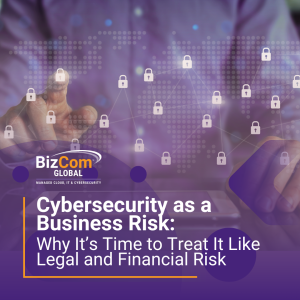
In today’s business climate, cybersecurity is no longer just an IT problem. It’s a business problem — and a growing one.
Every week, we see headlines about ransomware attacks, phishing scams, or breaches of customer data. But the bigger story isn’t about technology. It’s about leadership — and whether business owners and executives are actively managing cybersecurity risk with the same seriousness as legal or financial exposure.
The Leadership Disconnect
Many companies still place cybersecurity squarely in the hands of their IT team. And while your IT provider or internal tech support might do a great job of managing updates, firewalls, and user access, they can’t make business decisions on your behalf.
- Are you evaluating your cyber insurance coverage and whether it would actually pay out if you had an incident?
- Do you have a plan in place for what to tell clients and stakeholders if data is compromised?
- Are your contracts with vendors and partners protected by clear security expectations?
These questions don’t belong on a help desk ticket. They belong in the boardroom.
Why Cybersecurity Risk Is Business Risk
Here’s how cybersecurity touches almost every area of business performance:
- Reputation: A single breach can break client trust and damage your brand for years.
- Compliance: Failing to follow regulations like HIPAA, PCI DSS, or FTC Safeguards can result in fines or worse.
- Operations: Ransomware or network failures can bring business to a halt — costing you thousands (or more) per hour.
- Insurance: Policies now require specific security protocols. If you can’t prove compliance, your claim could be denied.
Think of cybersecurity the same way you think about liability protection or financial controls. You don’t wait for a lawsuit to talk to your attorney. You don’t wait for bankruptcy to call your accountant. Cybersecurity deserves the same proactive attention.
What Smart Leaders Are Doing Differently
Forward-thinking executives are shifting how they approach cybersecurity:
- Starting with a Risk Assessment to understand current risks and prioritize fixes.
- Reviewing vendor and partner agreements to align on shared security expectations.
- Including cybersecurity in leadership discussions — not just IT meetings.
- Investing in employee training to reduce risk from phishing and social engineering.
Reassessing business continuity and incident response plans to ensure resilience.
Final Thought: It’s Time to Own the Risk
You don’t have to be technical. You don’t have to understand every security protocol. But as a business leader, you do have to own the risk.
That starts with visibility, awareness, and asking the right questions. If you haven’t had that conversation yet — or if you’re not sure where to begin — we’re here to help.
Need a Cybersecurity Gap Analysis or a leadership-level briefing?
Visit BizComGlobal.com or book a call with our team to get started (919) 855-8399.

